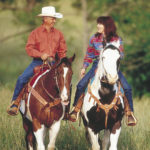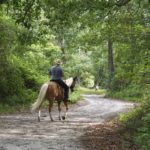American Quarter Horse Association

Hunt Seat Equitation: Tests an amateur or youth?s ability to ride–not the performance of the horse. Contestants work a predetermined pattern consisting of maneuvers such as changing gaits; travel in a figure-eight pattern; backing up as well as posting on correct diagonal and counter-cantering. Top riders return to be judged as they travel the perimeter of the arena performing gait changes at the judge?s discretion. Emphasis is placed on ability to sit correctly, hold the correct riding posture and control the horse on a precise pattern.
Hunter Under Saddle: A preliminary class for English riding disciplines in which judges evaluate a hunter-type American Quarter Horse on the flat, at a walk, trot and canter. Emphasis is placed on smoothness of gait, free-flowing stride and willingness to perform. Exhibitors must wear traditional English attire.
Hunter Hack: A transitional English class between hunter under saddle and working hunter. Horses are required to jump two fences then put on the rail to walk, trot and canter both directions in the ring. Emphasis is on manner and way of going on the flat and style over fences.
Pleasure Driving: English rail class tests the horse’s ability to pull a two-wheeled cart and driver along the perimeter of the arena. The horse is exhibited at a walk and two speeds of trot called park gait and road gait. The horse is judged on straight and free movement, manners, and a bright expression while staying under the driver?s control at all times. Horses must not break into a canter at any time.
Green Working Hunter: An event designed for horses in their first year of showing over fences or those which have not earned more than 10 AQHA points in working hunter or jumping classes. Rules are the same as those in working hunter except the fences are not as demanding.
Working Hunter: An event that demonstrates the gracefulness of the American Quarter Horse as it maneuvers a course consisting of at least four obstacles but must jump a minimum of eight fences. Manners, style of jumping, flow of strides, balance and keeping an even hunter pace are factors in the judges? scoring.
Jumping: Jumping is a true test of a horse’s athletic ability to perform over fences. Jumping consists of at least four obstacles and a minimum of eight jumps. Scores are based on time and penalty faults. Faults are assessed when a horse refuses to jump, knocks down an obstacle, or causes an obstacle to be knocked down. Horses completing the course without faults return to compete in a timed ?jump-off? to determine final placings.
Equitation Over Fences: Designed for amateur and youth competitors, this event tests the rider?s seat, hands and ability to control and show an American Quarter Horse over fences. The course consists of at least four obstacles with a minimum of six jumps required. Jumping faults of the horse are not to be considered unless it is the result of the rider?s ability.
For more information, go to www.aqha.com/showing/guidetoshowing/classes.html.
American Paint Horse Association
Hunter Under Saddle: Wearing traditional English attire, riders in hunter under saddle present their Paints at a flat-footed walk; a brisk, cadenced trot; and a smooth canter. Competitors riding in hunter under saddle perform on the rail as a group.
Hunt-Seat Equitation: Hunt-seat equitation competitors are judged on their skills in the saddle. Each exhibitor performs an individual pattern that tests his or her ability to maintain correct posture in the saddle while working their mount.
Equitation Over Fences: The equitation rider is challenged over a course of fences in this event. Emphasis is placed on the rider’s ability to control and guide their horse as they accurately complete a designated course while maintaining correct posture. The course is similar to the working hunter class in that riders can be judged on their ability to establish an even hunting pace. How an exhibitor elects to ride the course, the pace and approach to the jumps are used to evaluate the exhibitor?s judgment and ability.
Hunter Hack: In this class, riders are required to jump their mount over two fences, as well as demonstrate the horse’s ability to provide a pleasurable ride at a walk, trot and canter. A horse’s performance is judged 70 percent on jumping style and 30 percent on rail work. Consideration is given to horses that demonstrate appropriate manners, fluid performance style and that maintain an even pace.
Working Hunter: In working hunter, rhythm and style are the elements judges look for when evaluating competitors. In this event, riders individually jump their mounts over a series of fences that simulate obstacles found in the hunting field. Horses are judged on their ability to maintain an even pace and negotiate the jumps in a graceful manner. If a horse knocks down a fence or refuses to jump, points are deducted from its score.
Jumping: An event that uses mathematics to determine the winner, the jumping class tests a horse’s ability to clear eight 3- to 3.5-foot-high obstacles without a fault. If a horse knocks down or refuses to jump an obstacle, points are deducted from its score. In jumping, the horse with the least number of faults wins the event. Should two or more horses have the same number of faults, a jump-off is held, with the horse completing the course with the least number of faults in the fastest time receiving the higher placing.
For more information, visit www.apha.org.
Arabian Horse Association
Hunter Pleasure: Horses give the appearance of being a pleasure to ride while displaying a pleasant, relaxed attitude. They are ridden in informal hunter-style attire at a walk, trot, canter and gallop. The stride is regular, unconstrained and with good reach. Hunter Pleasure horses are judged on manners, performance, suitability as a hunter, quality and conformation.
Hunter Seat Classes: These classes test the rider’s ability to gracefully manage the obstacles faced in the hunting field. Both conformation and performance are important with different classes emphasizing one or the other.
Arabian Hunter horses are shown over a course of a minimum of eight fences that would be considered a fair test for hunters. The distance between fences is set at multiples of 12 feet. Amateur, Junior Rider and Green Working hunters will be asked to jump courses that are between 2’9″ and 3′ in height with spreads no greater than 3′. Courses for Regular Working hunters will be between 3′ and 3’3″. Warm-up hunter classes consist of no less than 6 fences at heights between 2′ and 2’6″.
Regular Working Hunter Under Saddle horses are shown at a walk, trot and canter. The judge may ask the horses to hand gallop one way of the ring. Horses should be obedient, alert, responsive and demonstrate free movement. A horse must be entered in at least one hunter class over obstacles to be eligible to enter and show in the Hunter Under Saddle class when it is counted toward a Championship.
Hunter Hack: Horses are shown at a walk, trot, canter and hand gallop. Horses will jump two fences at heights of between 2′ and 2’6″. This class is judged on performance, manners and soundness. This class does not count toward any championship.
Arabian Hunters are shown in light, hunter type bridles with cavesson nosebands. Breast collars are optional. Martingales are not allowed in Hunter Hack, Under Saddle or tie-breaking classes. Boots and bandages are prohibited. Arabian Hunter championships are offered at shows where a minimum of three classes are held, one of which must an Under Saddle class and the other two over fences. Hunters will receive points in each class toward a show championship.
Equitation Classes: The rider is judged on the ability to maintain form and control on the flat and while jumping over fences.
Appointment Classes: This class emphasizes fox hunting clothing and tack. In some cases these events are limited to members of recognized hunts.
Jumping: Arabian jumpers are shown over courses of fences and are scored according to the US Equestrian Federation rules. The course and the order in which the horses jump will be posted at least one half our prior to the start of the class. Obstacles in Amateur and Junior to Ride classes will start at 3′, with a maximum height of 3’3″. Spreads can be up to 4′ wide. Open Jumpers start at 3’3″ to a maximum of 3’6″ and with spreads to 5′. Horses may be shown in any type of English saddle. Any type of bridle is aloud. Martingales, tie downs, boots and bandages are allowed.
Dressage: Managed primarily by the US Dressage Federation. Recognized dressage competitions use tests issued by the USEF. These tests are designed to confirm the horse’s ability to perform at a specific level according to the objectives and standards of USEF.
Information from www.arabianhorses.org
Learn more about showing in breed competition from successful riders and trainers who have a boot in a both open and breed association competitions in ?Breed Show Primer? in the January 2010 issue of Practical Horseman magazine.
From www.equisearch.com





